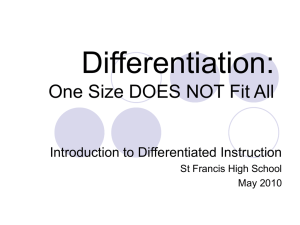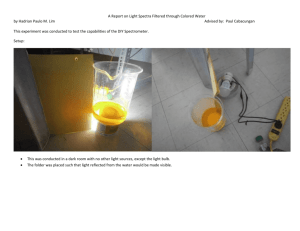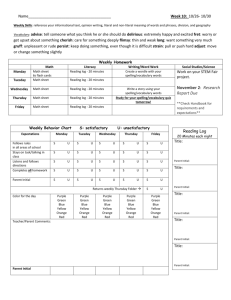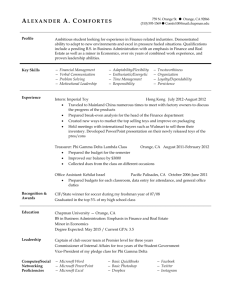DI08_wkshp1
advertisement
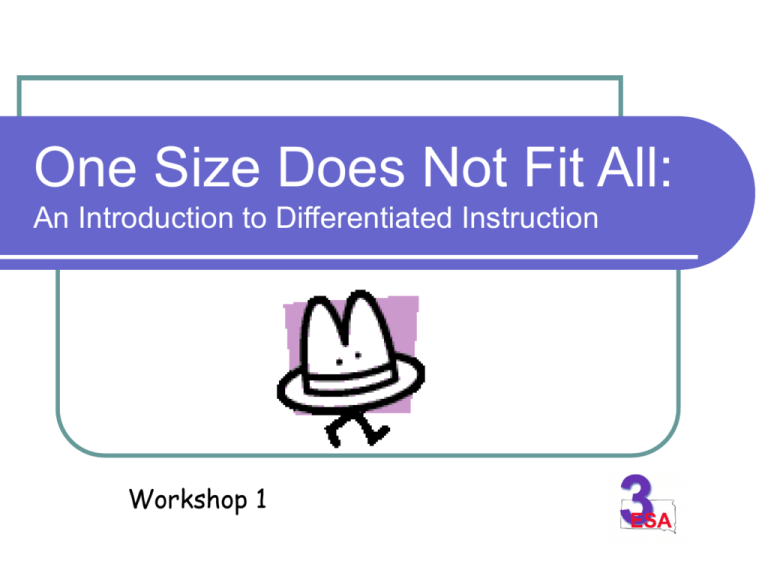
One Size Does Not Fit All: An Introduction to Differentiated Instruction Workshop 1 Take Care of Business Introductions Expectations Graduate Credit Service Agreements & Vouchers How well do YOU know the people around you? 3 Facts & a Fib Write 3 facts about yourself Write 1 fib about yourself Circulate & talk to 5 people If they do not correctly identify the fib, they must sign your postcard Workshop Outcomes Increased understanding of what Differentiated Instruction IS & IS NOT Add to our Instructional Strategies Toolbox Increased understanding of theories of multiple intelligence/learning styles Begin planning a differentiated lesson/unit for your own classroom “If students don't learn the way we teach them, we must teach them the way they learn.” - Marcia Tate, Developing Minds Inc., Conyers, GA What Is Your North Star? Peter H. Reynolds Listen to the story online http://www.fablevision.com/place/r adio/ns.html Read it online http://www.fablevision.com/northst ar/index.html Differentiation IS NOT . . . The same as an IEP for every student Just another way to group kids Expecting less of struggling learners than of typical learners A substitute for specialized services Chaotic New Good Differentiation IS . . . Varied avenues to content, process, product Respectful of all learners Proactive Student-centered A blend of whole class, small group, and individual instruction Based on students’ readiness, interests, and/or learning profile Essential Questions Who are the students in our classrooms? What diversity impacts and influences curriculum and instruction? Diversity in the Classroom ADD ADHD Gifted/Talented LD Vision Impaired Hearing Impaired Maturity Autistic Physically Disabled Multiple Handicapped English Language Learners Social Status Economic Status 3 Keys to Differentiated Instruction Content Process What we teach students Materials and methods used Activities Calls on students to use key skills Product How students show what they have learned Should also allow students to extend what they learned Key #1 – Adapt Content Refers to both materials & methods Accommodate students’ different starting points Some students ready for more complex or abstract levels Some students ready for independent work Content Differentiation Examples Multiple versions of texts Variety of texts to support concept Interest centers Learning contracts Support systems Audiotapes Mentors Study partners Key #2 – Adapt Process Students use key skills Bloom’s Taxonomy Multiple Intelligence Theories Common focus Vary student activities Teacher uses a variety of methods Process Differentiation Examples Tiered Assignments Layered Curriculum (Nunley) Learning Centers Jig Saw Assignments Learning Logs Graphic Organizers Modify their environment (fidgets) Key #3 – Adapt Product Culminating learning experience that occurs after many days or weeks of study Demonstration and extension of what they know, understand, and are able to do Product Differentiation Examples Variety of assessment types Tiered Assignments Independent Study Variables to Consider Readiness – in reading, math, & beyond Complexity & Challenge of both process & product Pace of learning and production Grouping practices Use of assessment results to inform teaching and learning Guidelines for the DI Classroom Focus on essentials Attend to student differences NO strategy works on ALL students Assess often and use it to make adjustments/modifications Mutual respect Be flexible Doesn’t happen 100% of the time!!!! Simple Ways to Start Add an interdisciplinary element to a favorite unit Collaborate with other teachers Offer students a variety of presentation options Apply Multiple Intelligence thinking to group/individual projects Time For a Break A Few Fun Strategies Teach In Color! Creature Comforts! Music! Color Increases Understanding Using color for key concepts can increase memory retention up to 25% Experiment Memorize the Pattern 30 seconds Orange Orange Red Red Yellow Yellow Purple Purple Pink Pink Orange Orange Yellow Yellow Blue Blue Black Black Red Red Blue Blue Green Green Memorize the Colors Used 30 seconds Purple Purple Orange Orange Yellow Yellow Blue Blue Red Red Orange Orange Yellow Yellow Green Green Blue Blue Purple Purple Green Green Orange Orange Memorize the Pattern 30 seconds Orange Orange Blue Green Green Purple Purple Purple Purple Yellow Pink Pink Red Red Red Red Orange Blue Blue Green Green Teach in Color Color Code Key Concepts Colored Pens Color with Sunshine Painted Essay Colored Acetate Number chart Sliding mask Highlighting tape Scotopic Sensitivity Syndrome A Quick Start “Color Code” key concepts Easy in modern classrooms White boards, Smart Boards, & computer software Key terms in all content areas Math (parts of equations) Language arts (parts of speech, important vocabulary, editing) Correct “with sunshine” Students do their own color coding Highlighting Tape Colored pens/pencils/highlighters Word Walls in Color CALEB GATTEGNO Correct “With Sunshine” Use yellow highlighter to identify incorrect answers Give student option to correct and receive partial (or whole) credit Key to success – require students to explain in writing what they did wrong and how they corrected the problem Use Colored Pens/Pencils In writing for peer editing Each member of group gets a different color Can instantly see if everyone has contributed Option – students use colored pen for their own editing/revising For language study of verbs Color code the different tenses Color code the verb endings Color code roots/prefixes/suffixes Skier (to ski) Je skie Tu skies Il/elle/on skie Nous skions Vous skiez Ils/elles skient The Painted Essay Peripherals Post key concepts or terms on walls Use bright colored paper At test time . . . Leave it up in same place Cover the concept with the same color paper Memory trigger for visual learners They can “picture” the words. Vision & Learning “25% of students in grades k-6 have visual problems that are serious enough to impede learning.” (American Public Health Association) “It is estimated that 80% of children with a learning disability have an undiagnosed vision problem.” (Vision Council of America) 20/20 does not mean that vision is perfect! The 20/20 vision test does not test how well you see at reading distance. In fact, the 20/20 test fails to evaluate many other important aspects of normal vision such as: Eye focusing Eye coordination Eye teaming (binocular vision) Eye movement Visual perceptual skills Color vision Simple Tools Sliding Masks & Focus Frames Provides for a narrower focus Add colored acetate Book Marks & Sticky Flags Provides focus Add colored acetate Coded Bookmarks Sticky Flags Scotopic Sensitivity Syndrome 12% of population Contrast problems (only 1 symptom) Black text on bright white paper Striped patterns on carpet clothes seem to move Vertical/horizontal blinds Leads to classroom difficulties Restlessness Difficulty staying on task Scotopic Sensitivity Syndrome Contrast problems (only 1 symptom) Strategies Use dull colored paper for writing Use colored acetate over black text on white paper Use a bookmark when reading to avoid losing place http://www.hale.ndo.co.uk/scotopic/ http://www.irlen.com/sss_main.htm Creature Comforts Grades K-12 Tolerance for sitting will ALWAYS be at different levels for different people. Even adults benefit from Fidgets or Movement Set ground rules in the classroom. Remove “it” if/when it becomes a toy or distraction Tactile Fidgets Grades K-12 Paper clip Cellophane tape rolled backwards around a finger Pipe cleaners Stress balls Pocket Fidget (small item kept in the child’s pocket) Carpet square under desk Visual Fidgets Grades K-12 Lava lamp Fish tank Mobile Nomadic Learners “If we build in enough movement during the class period, students will be less likely to move on their own.” Motion resources Minds in Motion Learning on Their Feet http://doe.sd.gov/oess/schoolhealth/mindsinmotion/index.asp Ideas for the Nomadic Learner Mini Field Trip A Home Away From Home Music Stand Learning Rocking Chair Reversal Act It Out – Visual Clues Grades 4-12 Vocabulary strategy for the Kinesthetic Learner Place students into groups Provide 60 seconds to figure out how to Act Out a vocabulary word Example – PERIMETER (walking around edge of room) perimeter area Involve the Senses See Hear Taste Smell Touch The Role of Music Why Music? Stimulates the brain Right side for creativity Activates thinking parts of the brain Creates a sound curtain to isolate groups Increases attentiveness Effects emotions, heart rate, mood, mental images of listener Embeds learning faster Alphabet song http://www.school-house-rock.com/Prea.html Time For Lunch Multiple Intelligences Begin With the Brain Dots on Grids A B C D Brain Principles The brain is a complex adaptive system. The brain is social. The search for meaning is innate. The search for meaning occurs through patterning. Emotions are critical to patterning. Every brain simultaneously perceives and creates parts. More Brain Principles Learning involves both focused attention and peripheral perception. Learning always involves conscious and unconscious processes. We have at least 2 ways of organizing memory. Learning is developmental. Complex learning is enhanced by challenge and inhibited by threat. Every brain is uniquely organized. Simple Learning Styles Auditory Visual Learns best from listening Learns best from seeing Kinesthetic/Tactile Learns best from doing Why Visual Literacy? Average youth today By age 18 - 22,000 hours watching TV By age 14 has seen 12,000 murders on network TV programming!!!! By 18 – 12,500 hours in school Average vocabulary of 14-year-olds is shrinking In 1950 – 25,000 words In 1999 – 10,000 words Visual Learner Images go directly to long-term memory in brain Humans process visuals 60,000 times faster than text Words processed sequentially Keyboard Images processed simultaneously Camera Turn Your Paper Sideways Grades 2-7 (or higher if needed) A trick for lining up numbers when working with multi-digit numbers in columns TURN THE PAPER SIDEWAYS & use the lines as column guides Also provides novelty (brain trigger) Jig-Saw Book Good tool for kinesthetic learners They can manipulate the content Gardner’s Multiple Intelligences Logical/Mathematical Visual/Spatial Musical/Rhythmic Bodily/Kinesthetic Naturalist Interpersonal Intrapersonal Verbal/Linguistic Sternberg Intelligences Analytical Practical Creative Time For a Break Writing Intelligence Preference Lesson Plans As a result of the lesson, students should Know what? Understand what? Be able to do what? What range of learner needs in your class relate to the topic? Difficulty vs Rigor “ We must be careful not to assign more difficult tasks (tasks requiring more effort or time) when what we mean to do is challenge students with more rigorous tasks (tasks requiring more complex thought).” Judith Dodge - Differentiation in Action Assignments for Next Time Try a new strategy & report back to the group about the experience Begin the planning process for a lesson using intelligence preference Choose a standard (or standards) to teach Identify student goals for that standard Choose possible strategies Be prepared to share with the group He Was Me Resource - Nunley Website HOT TOPIC # 1: When counting, gestures help. Researchers discovered that when students have to count things, those that could point, nod or otherwise make body gestures, were faster and more accurate than those who were not allowed to gesture. The gesture apparently adds rhythm which makes counting more accurate and also aids the brain in maintaining place. Carlson, R. et al. (2007). Journal of Experimental Psychology: Learning, Memory & Cognition, Vol 33, 4 Teacher Tip # 2: We use music for transition times in class and between class periods. I ask for student volunteers to bring in a CD of their choice for us to use for the week. No name, workshop participant, Midland, Michigan. You can subscribe to this newsletter at: http://help4teachers.com/newsletter.htm Facilitated By Sara Fridley & Kathleen West Region 3 Education Service Agency sara.fridley@k12.sd.us kathleen.a.west@k12.sd.us Have You Visited Lately? http://sdesa.k12.sd.us

